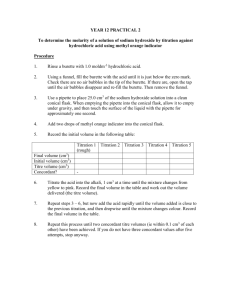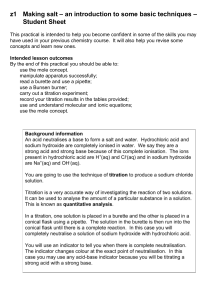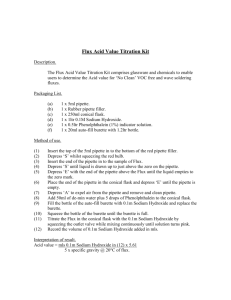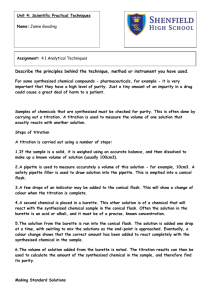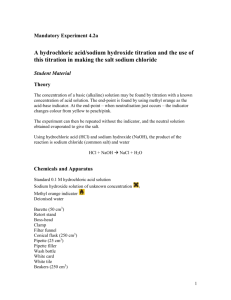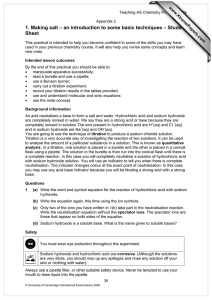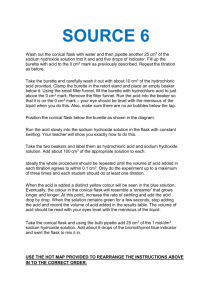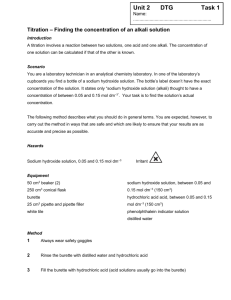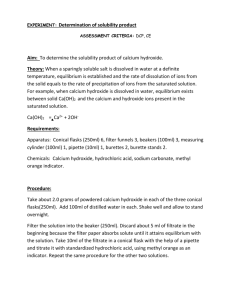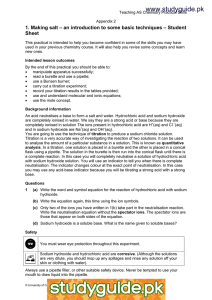File
advertisement
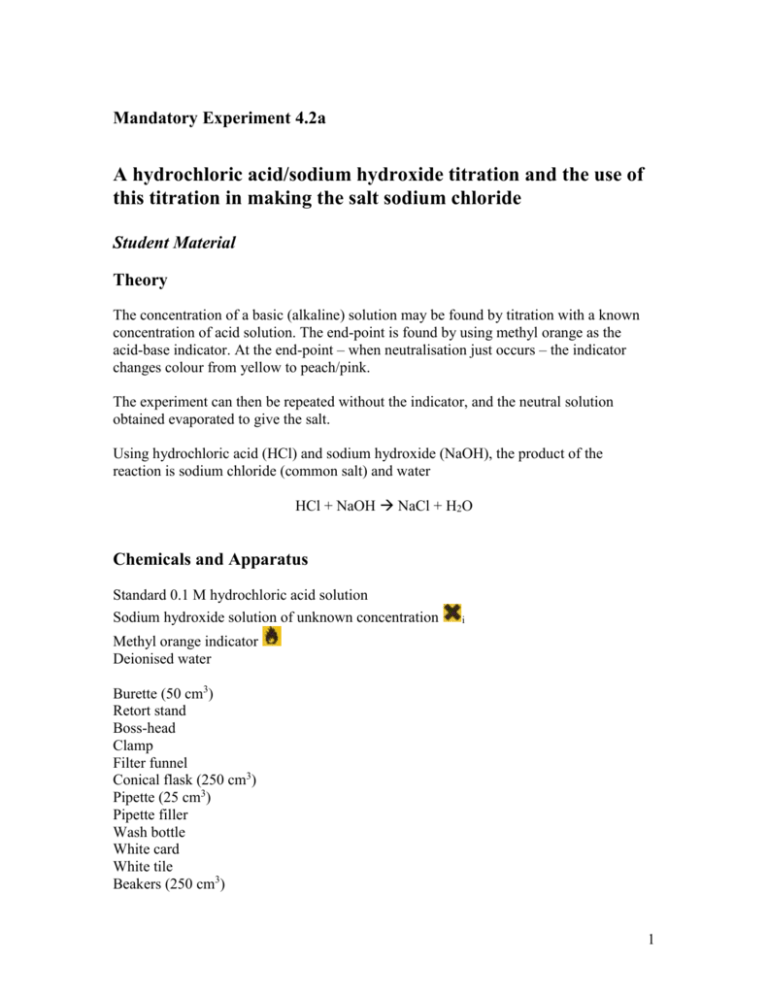
Mandatory Experiment 4.2a A hydrochloric acid/sodium hydroxide titration and the use of this titration in making the salt sodium chloride Student Material Theory The concentration of a basic (alkaline) solution may be found by titration with a known concentration of acid solution. The end-point is found by using methyl orange as the acid-base indicator. At the end-point – when neutralisation just occurs – the indicator changes colour from yellow to peach/pink. The experiment can then be repeated without the indicator, and the neutral solution obtained evaporated to give the salt. Using hydrochloric acid (HCl) and sodium hydroxide (NaOH), the product of the reaction is sodium chloride (common salt) and water HCl + NaOH NaCl + H2O Chemicals and Apparatus Standard 0.1 M hydrochloric acid solution Sodium hydroxide solution of unknown concentration i Methyl orange indicator Deionised water Burette (50 cm3) Retort stand Boss-head Clamp Filter funnel Conical flask (250 cm3) Pipette (25 cm3) Pipette filler Wash bottle White card White tile Beakers (250 cm3) 1 Safety glasses Procedure NB: Wear your safety glasses. (a) To find the end-point accurately 1. Rinse the burette, pipette and conical flask respectively with deionised water. 2. Rinse the burette with hydrochloric acid solution, and rinse the pipette with sodium hydroxide solution. 3. Using the pipette, transfer 25 cm3 of the unknown sodium hydroxide solution into the clean conical flask. Add 5 drops of methyl orange indicator. 4. Fill the burette to the 0 cm3 mark with hydrochloric acid solution. 2 5. Carry out one rough and two accurate titrations. 6. Calculate the concentration of the sodium hydroxide solution. (b) To obtain a sample of salt 1. To 25 cm3 of the sodium hydroxide solution in a beaker, add just enough hydrochloric acid to exactly neutralise it. The indicator should not be added. 2. Gently heat the solution until all the water has evaporated to dryness. A sample of sodium chloride will remain in the beaker. Table of Results Rough titre Second titre Third titre Average of accurate titres Volume of sodium hydroxide solution used in each titration Concentration of hydrochloric acid solution Concentration of sodium hydroxide solution = = = = = = = Questions relating to the experiment 1. Describe, briefly, the washing/rinsing procedure for the apparatus before starting the titration. 2. Mention two other precautions that should be taken to ensure accuracy when using a pipette. 3. Mention three operations, which should be carried out during the titration to ensure an accurate titre. 4. Suggest another suitable indicator for this reaction. How would you test to see whether your suggestion would work? 5. Why is it undesirable to put the sodium hydroxide solution into the burette rather than in the conical flask? 6 Can you suggest a means of neutralising a (a) HCl and (b) HNO3 acidic effluent from a manufacturing process to enable it to be disposed of safely? Write the chemical equations for the appropriate reactions. 3 Solutions to student questions 1. Describe, briefly, the washing/rinsing procedure for the apparatus before starting the titration. Rinse the burette, pipette and conical flask respectively with deionised water. Rinse the burette with hydrochloric acid solution, and rinse the pipette with sodium hydroxide solution. 2. Mention two other precautions that should be taken to ensure accuracy when using a pipette. Make sure that it is filled exactly to the mark. Allow it to release its contents freely, and then touch it to the inside of the conical flask for a few seconds. 3. Mention three operations that should be carried out during the titration to ensure an accurate titre. Swirl the contents of the conical flask after each addition of acid to the conical flask. Using a wash bottle, wash down with deionised water any solution adhering to the sides of the conical flask. Take all burette readings at eye level. 4. Suggest another suitable indicator for this reaction. How would you test to see whether your suggestion would work? Methyl red (or phenolphthalein). Repeat the experiment to see if the same result was obtained. 5. Why is it undesirable to put sodium hydroxide solution into the burette rather than in the conical flask? If the burette is not washed out very thoroughly after use, sodium hydroxide may crystallise in the Teflon tap causing blocking of the burette nozzle, or, at best, changing the concentration of the delivered solution.(If a burette with a glass tap is being used, the tap is likely to get stuck.) 6. Can you suggest a means of neutralising a (a) HCl and (b) HNO3 acidic effluent from a manufacturing process to enable it to be disposed of safely? Write the chemical equations for the appropriate reactions. Neutralise with NaOH solution. HCl + NaOH NaCl + H2O HNO3 + NaOH NaNO3 + H2O 4
